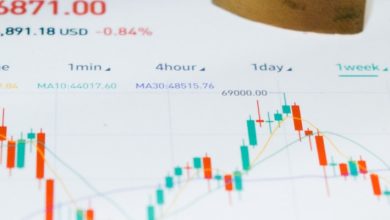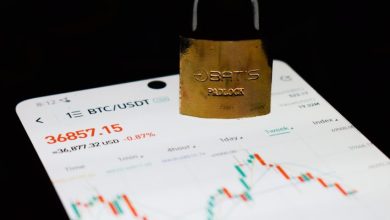How Market Trends Are Shaping the Future of DeFi

- Understanding the current landscape of decentralized finance (DeFi)
- Exploring the impact of market trends on the growth of DeFi
- Key market indicators influencing the future of DeFi
- The role of innovation in shaping the trajectory of DeFi
- Challenges and opportunities in the evolving DeFi market
- Predictions for the future of DeFi based on current market trends
Understanding the current landscape of decentralized finance (DeFi)
Decentralized finance (DeFi) has been gaining significant traction in the financial world, offering innovative solutions and disrupting traditional financial systems. To understand the current landscape of DeFi, it is essential to delve into the various market trends that are shaping its future.
One of the key trends in DeFi is the proliferation of decentralized exchanges (DEXs), which allow users to trade cryptocurrencies directly with one another without the need for intermediaries. This peer-to-peer trading model has gained popularity due to its lower fees and enhanced security features compared to centralized exchanges.
Another important trend in DeFi is the rise of decentralized lending and borrowing platforms, such as Compound and Aave. These platforms enable users to lend out their cryptocurrencies and earn interest, or borrow assets by using their existing crypto holdings as collateral. This trend has opened up new opportunities for individuals to access liquidity and earn passive income.
Furthermore, the concept of yield farming has become increasingly prevalent in DeFi, where users can earn rewards by providing liquidity to various DeFi protocols. This practice incentivizes users to participate in the ecosystem and helps to improve the overall efficiency of DeFi platforms.
Overall, the current landscape of DeFi is characterized by a diverse range of innovative projects and applications that are revolutionizing the way we think about finance. As market trends continue to evolve, it is clear that DeFi is here to stay and will play a significant role in shaping the future of the financial industry.
Exploring the impact of market trends on the growth of DeFi
The growth of DeFi is significantly influenced by various market trends that continue to shape its future. Understanding these trends is crucial for investors and developers looking to capitalize on the opportunities presented by decentralized finance.
One of the key market trends impacting the growth of DeFi is the increasing adoption of blockchain technology. As more businesses and individuals recognize the benefits of decentralized systems, the demand for DeFi platforms and services continues to rise. This trend is driving innovation in the DeFi space, leading to the development of new products and services that cater to a wider range of users.
Another important market trend is the growing interest in decentralized exchanges (DEXs). These platforms allow users to trade cryptocurrencies directly with one another, without the need for a centralized intermediary. The popularity of DEXs has soared in recent years, as users seek more control over their assets and transactions. This trend is expected to continue as DeFi projects enhance the functionality and user experience of decentralized exchanges.
Furthermore, the rise of yield farming and liquidity mining has had a significant impact on the growth of DeFi. These mechanisms incentivize users to provide liquidity to DeFi platforms in exchange for rewards, driving up the total value locked in these protocols. As more users participate in yield farming and liquidity mining, DeFi projects are able to attract more capital and expand their offerings, leading to further growth and innovation in the space.
Key market indicators influencing the future of DeFi
Several key market indicators are shaping the future of DeFi, with significant implications for the industry as a whole. These indicators provide insights into the trends and dynamics that will drive the evolution of decentralized finance in the coming years.
- Market Capitalization: The total market capitalization of DeFi projects is a crucial indicator of the industry’s growth and potential. As this figure continues to rise, it signals increasing investor interest and confidence in decentralized finance.
- Trading Volume: The trading volume of DeFi tokens on various platforms reflects the level of activity and liquidity in the market. Higher trading volumes indicate a vibrant ecosystem with active participation from traders and investors.
- User Adoption: The number of users engaging with DeFi protocols is a key metric for assessing the industry’s reach and impact. As more users join decentralized finance platforms, the sector gains credibility and momentum.
- Regulatory Environment: Regulatory developments play a crucial role in shaping the future of DeFi. Changes in regulations can impact market sentiment, investment decisions, and the overall growth trajectory of decentralized finance.
- Technological Innovation: Advancements in blockchain technology and smart contract capabilities drive innovation within the DeFi space. New developments enable the creation of more sophisticated financial products and services, expanding the possibilities for decentralized finance.
By monitoring these key market indicators, industry participants can gain valuable insights into the trends and developments that will shape the future of DeFi. Understanding these factors is essential for navigating the rapidly evolving landscape of decentralized finance and capitalizing on emerging opportunities.
The role of innovation in shaping the trajectory of DeFi
Innovation plays a crucial role in shaping the trajectory of decentralized finance (DeFi) as it continues to evolve and expand. The constant drive for innovation within the DeFi space has led to the development of new products, services, and protocols that are revolutionizing the traditional financial system. These innovations are driving the growth of DeFi and attracting more users and investors to the ecosystem.
One of the key aspects of innovation in DeFi is the development of new decentralized applications (dApps) that offer unique features and functionalities. These dApps provide users with a wide range of options for managing their assets, accessing lending and borrowing services, and participating in decentralized exchanges. The continuous innovation in dApp development is fueling the growth of DeFi and expanding its reach to a wider audience.
In addition to dApp development, innovation in DeFi also encompasses the creation of new financial products and services that leverage blockchain technology and smart contracts. These products and services enable users to engage in various financial activities such as yield farming, liquidity provision, and synthetic asset trading. The innovative nature of these products is attracting more users and capital to the DeFi ecosystem, further driving its growth and adoption.
Overall, innovation is a driving force behind the rapid evolution of DeFi and is shaping its trajectory towards becoming a mainstream alternative to traditional finance. As developers continue to push the boundaries of what is possible with blockchain technology, the future of DeFi looks promising, with endless possibilities for growth and development.
Challenges and opportunities in the evolving DeFi market
The evolving DeFi market presents a multitude of challenges and opportunities for investors and developers alike. One of the main challenges is the issue of security, as the decentralized nature of DeFi platforms can make them vulnerable to hacks and exploits. However, this also presents an opportunity for developers to innovate and create more secure protocols.
Another challenge in the DeFi market is the lack of regulation, which can lead to uncertainty and potential risks for investors. On the other hand, this lack of regulation also provides an opportunity for DeFi projects to operate more freely and experiment with new ideas without being bound by traditional financial regulations.
One of the biggest opportunities in the evolving DeFi market is the potential for financial inclusion, as DeFi platforms have the ability to provide financial services to individuals who are underserved or excluded by traditional banking systems. This can help bridge the gap between the unbanked and the traditional financial system.
Additionally, the DeFi market offers opportunities for investors to earn passive income through staking, liquidity mining, and other forms of yield farming. These opportunities can be lucrative for those willing to take on the associated risks and stay informed about market trends and developments.
In conclusion, the evolving DeFi market presents both challenges and opportunities for participants. By addressing security concerns, navigating regulatory uncertainties, and leveraging the potential for financial inclusion and passive income, investors and developers can help shape the future of DeFi and drive its continued growth and evolution.
Predictions for the future of DeFi based on current market trends
Looking at the current market trends in the world of decentralized finance (DeFi), it is clear that the sector is experiencing rapid growth and innovation. Based on these trends, we can make some predictions about the future of DeFi.
- Increased adoption: As more traditional financial institutions and retail investors become aware of the benefits of DeFi, we can expect to see a significant increase in adoption rates. This will lead to a larger user base and more capital flowing into the DeFi ecosystem.
- Regulatory challenges: With the growing popularity of DeFi, regulators around the world are starting to take notice. We can anticipate that there will be increased scrutiny and potential regulatory challenges for DeFi projects. It will be crucial for the industry to find a balance between innovation and compliance.
- Technological advancements: As the DeFi space matures, we can expect to see continued technological advancements. This could include improvements in scalability, interoperability, and security. These advancements will help DeFi platforms handle a larger volume of transactions and provide a better user experience.
- Competition and consolidation: With the increasing number of DeFi projects entering the market, we can anticipate heightened competition. This could lead to some projects merging or being acquired by larger players. Consolidation in the industry is a natural part of the growth process and can help strengthen the overall DeFi ecosystem.
- Emergence of new use cases: As DeFi continues to evolve, we can expect to see the emergence of new and innovative use cases. This could include decentralized insurance, prediction markets, and asset management solutions. These new use cases will expand the utility of DeFi and attract a broader range of users.





